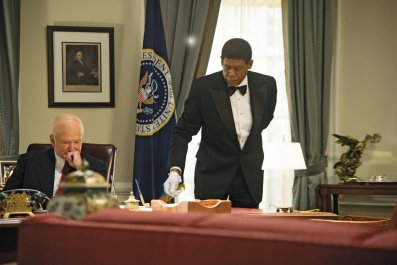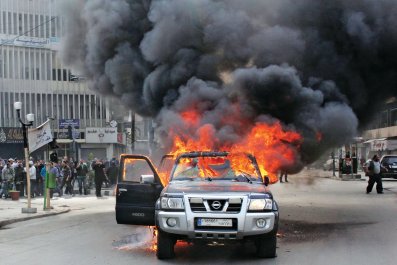In 2007, a team of civilians with a rare set of specialized skills joined a brigade of the 82nd Airborne Division deployed to eastern Afghanistan. The civilian team's leader was a former Special Forces officer; he was accompanied by a West Point graduate who had studied anthropology and described herself as a "high-risk ethnographer." She asked reporters to identify her only as Tracy.
Tracy and her colleagues were part of the Human Terrain System, a project whose creators saw themselves as a band of progressive upstarts seeking to transform the Army from within. The program's goal was to draw on the tools of anthropology to help U.S. soldiers better understand Afghanistan.
Known as AF1, Tracy's group was the first Human Terrain Team to deploy in the field—and it quickly made an impact. In one community, Tracy pointed out that the Haqqani network, an anti-American group of insurgents, was gaining strength because an uncommonly large number of Afghan widows depended on their sons for support. With few jobs available, many young men were forced to join the insurgency to earn money. On the advice of the Human Terrain Team, soldiers started a job-training program that put the widows to work and cut the insurgents' supply of recruits. The Human Terrain Team even convinced the Army to refurbish a mosque on the American base—a project that was credited with cutting insurgent rocket attacks.
Not all of Tracy's insights led to perfect results, but on the whole the experiment appeared to be a major success. Tracy was "taking the population and dissecting it," an officer who worked with her told The Christian Science Monitor; she was giving soldiers "data points" that helped them resolve local disputes and identify problems before they turned violent. Col. Martin Schweitzer, the commander of the brigade with which Tracy had deployed, would become one of the Human Terrain System's biggest supporters. He believed that Tracy and her team had made U.S. soldiers and Afghans safer while speeding the work of connecting Afghans to their government. When Schweitzer had arrived in Khost, only 19 of 86 districts supported the U.S.-backed Afghan government. By the end of his deployment, he estimated that 72 of them did. He credited Tracy and her team with reducing his unit's combat operations in the province by 60 percent to 70 percent.
In attributing a measure of his brigade's success to the work of the Human Terrain Team, Schweitzer helped lay the groundwork for the project's extraordinarily rapid growth. By the fall of 2007, the Defense Department had authorized a $40 million expansion of the Human Terrain System that would more than quintuple the projected number of teams in Iraq and Afghanistan.
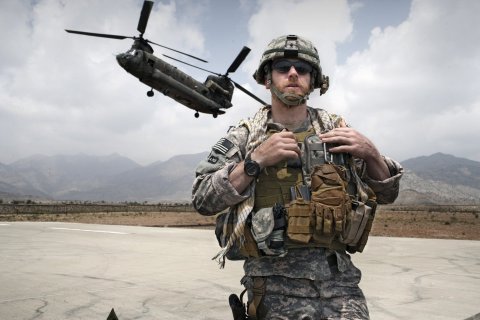
THE HUMAN Terrain System owed its creation to many different people, but one of the key players was a renegade anthropologist named Montgomery McFate. McFate was the product of contradictions: California beatnik counterculture, a familial fascination with the primitive "other," and a quiet but persistent strain of military DNA that was as mainline American as it got. Born in 1966 to a mother who made and sold faux ethnographic artifacts and a father who was a former Marine, she had grown up on a barge in a radical, chaotic houseboat community in Richardson Bay, near San Francisco. The writer Cintra Wilson, McFate's oldest and closest friend, described the houseboat communities of their childhood as a "social experiment." "We were essentially raised by pirates," Wilson told me.
McFate eventually attended community college, then Berkeley, then Yale, where she got her Ph.D. in anthropology. But even before she finished her dissertation, she had grown tired of anthropology. "I wanted to do something in the world, not just write about it," she told me. She went to Harvard Law School, where she met the young Army officer who would become her husband when he visited for a weekend. They moved to Germany, where he was stationed, before relocating to Washington, D.C. McFate took a contract job with the CIA, traveling to Europe to conduct research. She was not a clandestine agent, but neither did she tell her interview subjects that she worked for an intelligence agency. She moved on to the RAND Corporation, and in 2003, to the Office of Naval Research, which had supported the anthropologists Margaret Mead and Ruth Benedict half a century earlier. By this time, McFate had started to wonder in earnest how anthropology might contribute to the needs of a military she had grown to respect.
She began a concerted networking campaign. During a conversation with the commander of the Marine Corps Warfighting Laboratory, McFate suggested that cultural misunderstandings had caused difficulties for Marines in Iraq. "I don't have any facts about that," she recalled the general telling her. "I'd like you to do a study." She started interviewing Marines, and later soldiers and sailors, returning from Iraq. Somewhere along the way, she heard the name of a Pentagon science adviser and wrote it down, but she never got around to calling him. One day, out of nowhere, he called her. Could she come to the Pentagon?
The adviser's name was Hriar Cabayan. He was one of the Pentagon's biggest brains, and he was looking for an anthropologist to help him solve a critical problem. It was 2004, and buried bombs were killing 100 American soldiers a week in Iraq. But the Army knew almost nothing about who was planting the bombs, and why. Most soldiers spoke no Arabic. Whatever knowledge they gained about tribal and familial relations, economic behavior, and cultural nuances during their deployments was lost when they left and the next unit arrived. Cabayan recruited McFate to help him build an ethnographic database that could be loaded onto a laptop and used by soldiers in the field. It would later be called Cultural Preparation of the Environment, and it was an open-source intelligence tool designed to reduce violence by understanding the sea in which the enemy swam.
But McFate would soon advocate going a step further and sending civilian social scientists into the field with soldiers—the idea that eventually became the Human Terrain System. She was not the concept's only supporter; indeed, it's hard to attribute the idea to one person. A young Army Reserve captain named Don Smith, who would become the Human Terrain System's first program manager, told me he came up with the idea at his kitchen table. Steve Fondacaro, an iconoclastic, wiry, 30-year veteran of the military who would succeed Smith as the program's leader, said he was the one who pushed to send social scientists into conflict zones with soldiers.
At the time, the idea of installing a team of cultural experts in a military unit resonated within an Army that was doing some serious soul-searching. Thanks in part to Gen. David Petraeus, the Army was rethinking how to fight insurgencies—and arriving at the conclusion that a more thoughtful approach was needed in dealing with local populations. "Not understanding the human terrain has the same effect on your operations that not understanding the physical terrain has on conventional military operations," Petraeus would later tell me. "If you don't really appreciate the physical terrain and its impact on your operations, you don't succeed. If you don't understand the human terrain in the conduct of population-centric counterinsurgency operations, you don't succeed."
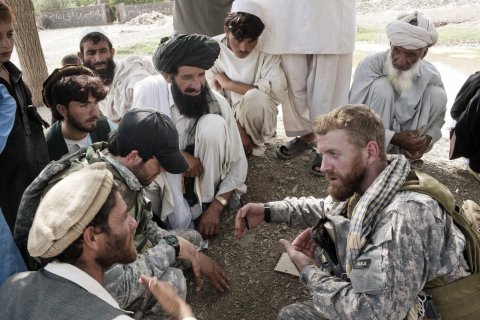
But while the use of anthropology made sense to some in the military, it deeply disturbed many anthropologists. Beginning in 2007, a small group of anthropologists carried on a vigorous, public argument with McFate and other champions of anthropology as a tool for counterinsurgency. McFate's critics advanced three main arguments: first, that deploying social scientists to war zones, particularly to gather military intelligence, could endanger the people being studied and lead all anthropologists to be viewed as spies; second, that anthropology is not predictive and does not yield the kind of data useful for military operations; and third, that, on principle, anthropology should not be used to subjugate unruly people while expanding American power.
Indeed, many anthropologists remembered how anthropology had been used as a tool of imperialism in the 1800s and early 1900s. "Of all the modern social sciences, anthropology is the one historically most closely tied to colonialism," Edward Said once wrote, "since it has often been the case that since the mid-nineteenth century anthropologists and ethnologists were also advisors to colonial rulers on the manners and mores of the native people to be ruled."
IN FEBRUARY 2009, I flew to Leavenworth, Kansas, to learn how the Human Terrain System prepared field team members for deployment to a war zone. The training at that time consisted of four to five months of classroom work that included basic social science and research methods, military rank structure, and courses on culture and history tailored to Iraq or Afghanistan. There was also a period of several weeks known as "immersion," when trainees bound for Afghanistan spent time at the University of Nebraska in Omaha, studying Dari and talking with Afghan-Americans, while those headed for Iraq undertook a special course at the University of Kansas.
My minder during my weeklong visit was Maj. Robert Holbert, an Army reservist and former high-school social-studies teacher who had served on the first Human Terrain Team in Afghanistan, and who embodied the offbeat, left-leaning vibe the program sought to project. A convert to Islam with a shaved head, Holbert drove a Saab and listened to the Sex Pistols.
Human Terrain System training took place in the basement of a brick mini-mall in downtown Leavenworth called the Landing. The old federal prison and the sprawling Army garrison that anchor the town lie about a mile to the northwest. Fort Leavenworth is home to midcareer master's programs for officers; it is where the Army contemplates its past and tries to get ahead of its future. The Human Terrain System laid claim to this spirit of military intellectualism, but if the rolling lawns of the base conjured a gracious university, the Landing had the dismal, downtrodden feel of an underfunded community college.
The program's administrators had told me that the most interesting part of the training cycle would be the final week, when proto–Human Terrain Team members took part in a practical exercise to test what they had learned. The exercise was called Weston Resolve, named for the town of Weston, Missouri, near Leavenworth, where some of it took place. The Human Terrain System's press handler, former Army intelligence officer Lt. George Mace—a veteran of the first Human Terrain Team to deploy in Iraq—described Weston Resolve to me as "a practicum in doing ethnography in any kind of village."
The exercise was an elaborate game that began with the imagined secession from the United States of a big swath of territory between the Dakotas and Missouri. In keeping with this fictional turn of events, separatist groups and criminal elements were supposedly making trouble in eastern Kansas, burglarizing a pharmacy in Leavenworth, among other misdeeds. The U.S. government feared that crime syndicates and terrorists would commandeer this unstable new quadrant of the heartland for their own ends, and they sought to bring the revolt under control. The trainees' job was to figure out as unobtrusively as possible what kind of people lived along the Kansas-Missouri border and to gather information about their customs, values, and beliefs.

The exercise began early on an icy morning in a parking lot a few blocks from the Landing. I followed the trainees around as they interviewed a young woman making smoothies at a local gym, a man on an exercise bike, mall walkers, college students, and people eating lunch at the food court on the nearby military base. The trainees asked people about their greatest successes and failures, whether it was appropriate in their culture for a little girl to talk to an older man she didn't know, and what they had worried about most in the last month.
"I've lived in Leavenworth my whole life and it's very trashy," the girl behind the smoothie counter told them. "That's my personal opinion."
"What's the most offensive thing you've seen someone do in public?" one of the trainees asked.
"Shoot someone," the girl said.
"What's the worst thing a friend can do?"
"Go behind my back and cheat with my boyfriend that I'd had for two years."
The Human Terrain System had been sold to the Army as a means of providing cultural knowledge to battlefield commanders. But as I watched the trainees interview residents near the Kansas-Missouri border, it became clear that whatever information they would be providing did not stem from any special knowledge of Iraqi or Afghan culture. Instead of offering cultural expertise, the Human Terrain System was training recruits to parachute into places they'd never been, gather information as quickly as possible, and translate it into something that might be useful to a military commander. One of the few Human Terrain social scientists I met with relevant experience, a Ph.D. candidate in anthropology who had done his dissertation fieldwork in Afghanistan, would describe his Human Terrain work as "windshield ethnography."
Thrown together at the Landing were former intelligence officers, defense-industry contractors, social scientists of various and often conflicting persuasions, military reservists, and immigrants with language skills. Teammates often shared little beyond a very general understanding of what they were doing and why. In the words of one former Human Terrain Team member, they specialized in "that touchy-feely thing that no one understood." Some thought they were part of a humanitarian aid mission. Others thought they were there to tell the commander why local people supported the insurgency. Still others saw it as a chance to play spy. I had expected to find wide-eyed hopefulness and team spirit. Instead—perhaps because three Human Terrain Team members had recently been killed in the field—the place had a tense, fevered quality.
From the program's beginning until at least late 2010, Human Terrain Team members got no operational security training, no survival skills beyond a brief medical course, no firearms training. "As a member of a 5-person HTS team, you will be safely attached to a brigade combat team," read a cheerful 2008 recruitment brochure from BAE Systems, the big defense contractor that hired Human Terrain Team members during that period. But what could being "safely attached" to a United States military unit in Afghanistan possibly mean? Some military units gave their Human Terrain Team members guns, but often the civilians had little or no idea how to use them.
On my first morning in Kansas, the cultural anthropologist in the group I was observing told me he didn't want anyone to know who he was. When I reminded him that I was a reporter and pointed out that the information he had already given me—including his surname and the name of a university where he had taught—would likely identify him, he grew agitated. "I'm an anthropologist," he told me. "I have a lot of anthropologist friends, and I don't want to get a bunch of emails telling me I'm the scum of the earth for joining this program."

IN MARCH 2009, I flew to Kandahar to embed with a Human Terrain Team called AF4, which was operating in Maiwand, a contested stretch of desert west of Kandahar. The team had recently been reconstituted after one of its members had been attacked by an Afghan and her teammate had responded by killing her assailant. The new team included a 64-year-old psychologist from Texas, a middle-aged former Marine, and a 31-year-old with a master's degree in Central Asian studies—none of whom had ever been to Afghanistan.
I wanted to believe in the Human Terrain System's capacity to make the U.S. military smarter, but the more time I spent with the team, the more confused I became. The psychologist, a tall man with wire-rimmed glasses named Karl Slaikeu, was a can-do type who had apparently figured out how to solve the region's security problems before ever setting foot in Afghanistan. One afternoon, I watched as he tried to convince two Canadian soldiers and a USAID officer who had been in Afghanistan far longer than he had that he understood the place better than they did. Later, I asked one of the Canadians what he thought of the Human Terrain Team members. "I don't know where they got these guys," the Canadian soldier told me, shaking his head.
Slaikeu had been issued an assault rifle but neither the Human Terrain System nor the Army had trained him to use it. He'd gone out and shot on a range near his home in Texas, and one of his teammates had taken him to shoot on a military range in Afghanistan.
The former Marine went by the nickname Banger. He wore a thick beard, carried copious ammunition, and sometimes advised Slaikeu not to chamber a round when we traveled in armored vehicles for fear the bespectacled social scientist's gun might fire by mistake when we went over a bump.
Early in my visit, when I was just getting to know the Human Terrain Team members, I accompanied Banger and some soldiers to a barbecue at a nearby Afghan army base. I liked Banger. He was refreshingly unpretentious. He had grown up on a farm in Iowa, and his understanding of rural, agrarian culture gave him a winning ease with the Afghan farmers he met on patrols. The Americans had organized the barbecue to celebrate the Persian New Year, Nowruz, and to boost the morale of the local Afghan army unit they were mentoring. They brought boxes of burgers, Rice Krispies treats, soda, and Gatorade, but the Afghans had other ideas. They invited the Americans to join them on a patch of gravel near the kitchen, where the cooks were about to slaughter a goat for lunch.
Banger and I went along to watch. We were deep in the Afghan south, but I noticed that many Afghan soldiers at the base were Tajiks from the north. This was not unusual; the Afghan army has had much greater success recruiting Tajiks than Pashtuns. As we stood there, two Afghans dressed in Army fatigue pants and plain T-shirts grabbed a goat that had been loping around the yard, and then proceeded to slaughter and skin it. These two men were dressed like the other soldiers, but they had smooth brown faces and the Asiatic features of Hazaras, an Afghan ethnic group concentrated in the center of the country. Hazaras have long occupied the lowest rung in Afghanistan's ethnic hierarchy, so it was no surprise that these men had the job of butchering an animal and cooking for the other soldiers. In Kabul, Hazara men haul carts like oxen and many Hazara women work as cooks and housemaids. I said something about this to Banger.
"What?" he said.
"Hazaras always get the worst jobs."
"Huh?"
It took me a few seconds to realize that he had no idea what I was talking about. "Look at those men," I told him, motioning toward the cooks. "Do you see any difference between them and the others?"
He thought about it. "I guess," he said.
Afghan tribal structures are complex and fragmented, but the fact that there are several major ethnic groups who control various regions of the country and don't always get along is about as basic as Afghan cultural knowledge gets. That Hazaras make up an often oppressed minority is not difficult to understand if you have spent five minutes observing the country. It would have been one thing if Banger had been an ordinary soldier. But soldiers and officers often described him and his teammates to me as "cultural experts." Banger had never before been to Afghanistan, but he had worked at the Army Culture Center and sat through five months of Human Terrain System training. I wondered how he had come so far without knowing what a Hazara was.
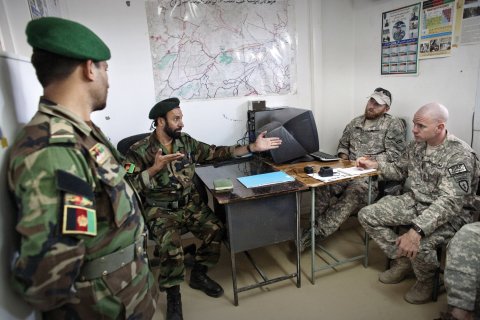
A year later, after a lengthy deployment in southern Afghanistan, Banger emailed me: "You should interview me now! I have learned a great deal. I can also differentiate between Hazara and Pashto." He was learning on the ground, just as soldiers did.
A more culturally knowledgeable member of AF4 was the 31-year-old. He spoke some Pashto and asked that I identify him only by his nickname, "Spen," an Afghan approximation of "Whitey." I had been warned by other members of the team that Spen was a disgruntled naysayer and that I shouldn't put much stock in what he told me. But as we walked the uneven gravel that covered the desert ground at Forward Operating Base Ramrod, Spen told me of his initial hope for the Human Terrain System and his subsequent disappointment.
By far the most serious problem, in his view, was the lack of specific cultural knowledge or expertise among Human Terrain Team members. What about you? I asked. Spen turned to me sharply. "This is my first time to actually live in Afghanistan, and I don't really even live in Afghanistan," he said. "I live on an American base with lots of young men from all over the United States, a lot of wonderful young men, but I don't live with Afghans. I hang out with the interpreters, who aren't even local. They're actually all from Kabul." He traveled to Afghanistan two or three times a week when he went out on patrols with the soldiers around the region. "I go to Afghanistan for half the day and I come back," he told me. "Other people have claimed I'm an expert after I've told them I'm not. The whole notion of being an expert I find very entertaining, because I think that's part of the problem of the U.S. situation in Afghanistan: we're being misled by a lot of self-proclaimed experts."
He was right about the lack of expertise, but the Army mostly didn't know the difference. For many young soldiers I met, cultural finesse still amounted to the response of a turret gunner one day on patrol, when an approaching car failed to heed the Americans' signals to slow down. The gunner remembered the Pashto word for "stop."
"Wadarega, motherfucker!" he bellowed, pointing his .50-caliber machine gun at the Afghan driver's head.
IN THE summer of 2009, 10,000 American Marines landed in Helmand province, the first wave of a troop surge that would build through mid-2010. A small number of British forces had been struggling and losing ground for years in the rural southwestern province, where the insurgency had dug in and metastasized. A new Human Terrain Team, known as AF6, was sent to work with the Marines at their main base, a sprawling desert outpost called Camp Leatherneck.
The team's leader was Steve Lacy, a thoughtful, serious Army officer and lawyer I'd met during my visit to Leavenworth. With him were Cas Dunlap, an information operations specialist, and AnnaMaria Cardinalli, a former FBI analyst, flamenco guitarist, and theology Ph.D. I wrote to ask Lacy if I could visit and spend a few weeks with his team. He agreed.
AF6 had been sent to Helmand too early. The team landed at Leatherneck at 3 a.m. in late April 2009, more than a month before the main Marine force arrived. In order to have something to do, Cardinalli temporarily joined the Human Terrain Team in Maiwand, while Dunlap was briefly attached to one at Bagram, north of Kabul.
A month later, Lacy summoned them both back to Helmand, where the Marines were settling in and exciting research possibilities were beginning to open up. But right away, problems arose. The Marine colonel supervising the Human Terrain Team didn't know what the team was supposed to do, but to be fair, neither did anyone else. Lacy and his teammates were figuring it out as they went along. AF6 had begun with four members, but one had immediately quit and returned to the States, and of the three who remained, two were women. The Marines disliked the idea of sending civilian women out on patrols in their new area. Unable to conduct the village and area assessments they had anticipated, Cardinalli and Dunlap headed to Lashkar Gah, Helmand's capital, where the British forces weren't afraid to work with them.
There, Cardinalli put together a report on homosexual behavior among Pashtun men, while Dunlap made herself useful advising British soldiers about the nuances of Taliban night letters. Night letters were threatening missives left in villages overnight for Afghans to find in the morning. The Taliban used them to intimidate Afghans so they wouldn't cooperate with NATO and the Afghan government. Such letters had long been a tool of revolutionary forces in Afghanistan and Iran. They testified to the insurgents' eerie intimacy with the villages and the countryside. In the morning, no one knew whether the letters had been left by an outsider or whether the author was one of their own.
A few days after I arrived at Leatherneck, I joined Cardinalli and a Marine unit known as Fox Company for an early-morning patrol to a cluster of compounds just outside the gates of the base. Cardinalli had olive skin, glasses, and long dark hair, which on this day she hid beneath a khaki bandanna. At Notre Dame, she had written a Ph.D. dissertation linking the musical and liturgical traditions of the Penitentes, a Catholic lay confraternity in northern New Mexico, to those of Christians, Muslims, and Jews in medieval Spain. When hijacked planes hit New York and Washington on September 11, 2001, Cardinalli had wanted to help. But given her background in music and theology, a practical role in the Global War on Terror wasn't immediately apparent.
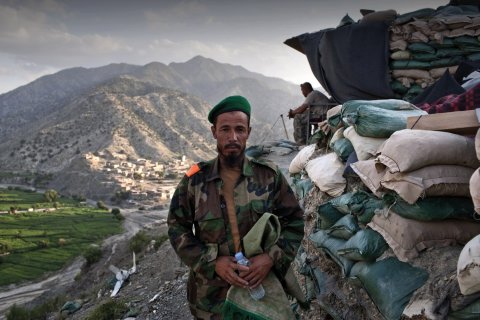
Nevertheless, she got to thinking about the connection between her research on the Penitentes and intelligence work. In her dissertation, she had written that the "secrecy" of the Penitentes made their communities difficult for an outsider to penetrate. Later, she would describe her dissertation research as "directly relevant to current intelligence and counterterrorism issues" and say that while working on it, she had "employed a variety of techniques typical of intelligence, investigative, and ethnographic work." She connected her research on the Penitentes to penitential themes in Shiite Islam and served as an intelligence analyst, deploying briefly to Iraq. "Being an activist type, I had a lot of preconceptions about how the military operated," she told me. Yet she was touched by the work U.S. soldiers were doing to improve Iraqi lives.
Cardinalli was now in the final days of an abbreviated tour as AF6's social scientist. This morning's patrol had grown out of a medical mission a few weeks earlier, when Cardinalli had accompanied female Marines and a female Navy doctor on a visit to the small group of houses that the Marines called Settlement 1. She had gone along on the medical mission because it offered a rare opportunity to interview Afghans in the desert around Leatherneck where few people lived. When the Navy doctor had finished talking to an Afghan family and doling out pills, Cardinalli had gotten to pose a few questions of her own, though the Afghans were not as forthcoming as she'd hoped. But the thing that struck Cardinalli most forcefully was the Navy doctor's lack of bedside manner. The Afghans had seemed to grow visibly angry when they were handed small packets of six or eight pills. The Marines didn't give out large quantities of medicine for good reason; they were doing all they could to prevent overdoses. But this concern struck Cardinalli as unimportant compared with the possibility that Afghans might view Americans as "stingy."
When the military doctor told people she could only give them a small number of pills, her words "were inevitably perceived by the local residents to be a lie," Cardinalli wrote later. Afghans "view American forces to be resource-rich and ... it is inconceivable that our supply would be so limited. Instead, local residents are forced to view the Americans with the anger of unfulfilled expectations and question the team's motives for intruding upon their homes in order to provide something of such little benefit."
Cardinalli wanted to make things right with the people of Settlement 1. For her followup mission, she had filled a camouflage backpack with over-the-counter cold medicine, ankle braces, Carmex lip balm, motion-sickness tablets, and pain relievers. She had gathered these medicines from boxes of donations outside the chaplain's offices around base or bought them at the PX. She had no medical training beyond a brief combat first-aid course, and when she told me about the mission, I wondered what the Afghans in Settlement 1 would do with all these pills and potions with their incomprehensible English instructions.
The officer in charge of Fox Company was a 38-year-old captain named Bob McCarthy. He wore his uniform open to reveal a triangle of chest and walked with a swagger. The Marines planned to hand out child-size Crocs, knapsacks, notebooks, cooking oil, beans, and tea. Before we set out, McCarthy told Cardinalli to make sure she took time to thoroughly explain the medicines to Afghans she met. But he also cautioned that the patrol would be short—a little over two hours. Some of us climbed into a Max Pro, a giant armored vehicle, while the rest of the Marines piled into Humvees. We drove about two miles over soft dunes studded with volcanic stones and climbed down near a scattering of compounds. Cardinalli and Flo, an Afghan-American interpreter from Los Angeles, pulled out a cardboard box full of book bags and school supplies. It said "The Church of JESUS CHRIST of Latter Day Saints" on the side. "I would just watch the box," McCarthy told them. Cardinalli stuffed it back into the truck.
She and Flo made their way to the nearest compound, where an Afghan dog, long-legged and rangy, barked at them. The man of the house had a tanned, open face, a clean beard, and dark hair under a white turban. He invited us inside. In a clean, sunlit room, Cardinalli and Flo arranged themselves on the floor across from a woman in a red sequined dress and matching headscarf. She held a baby with a blue pacifier on her lap and eight other children of varying ages clustered around her.
Cardinalli opened her bag of medicines. The Afghan man immediately assumed she was a doctor—the Marines had, after all, brought a doctor to visit his family before. He asked Cardinalli to feel his wife's stomach, which had been hurting since she had given birth to her latest set of twins. She had borne 10 children in all, the man told us, and her stomach tissue had stretched. It hurt when she did chores around the house. They'd been told that she needed an operation, but they couldn't afford it.
"Tell him that I'm not a doctor, but I'm a medic, a nurse," Cardinalli told Flo. She wasn't a medic or a nurse. She and her teammates had taken an emergency first-aid course before deployment, learning to clear an airway, bandage a bullet wound, and apply a tourniquet. "Obviously I can't do an operation," Cardinalli continued, "but what I can give her is things that can help relieve the pain." She dug into her backpack and pulled out a container of Icy Hot, a cream for arthritis and joint pain. She handed it to the Afghan man. "If the tissue hurts—when it's hurting—rub this cream on," Cardinalli said. "It'll feel hot at first, but then it will help the tissue. It'll ease the pain on the inside."
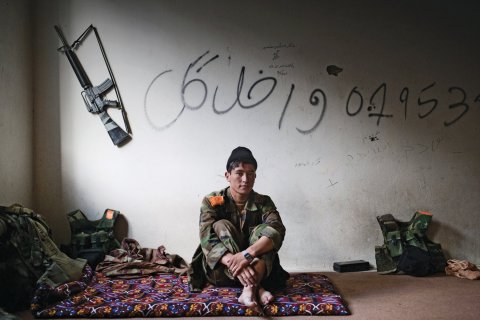
The man took the cream. The woman asked for food for her baby. Cardinalli offered them a handful of honey sticks and four strawberry protein bars from the chow hall on base, suggesting they dissolve the bars in milk. The woman said she was always in pain. Cardinalli handed her some pink tablets, a generic form of Pepto-Bismol. Flo dug into her bag and pulled out a pile of scarves. She handed them to the woman and her daughters.
Cardinalli scanned the room, gazing at the embroidery on the wall. "Her work is very beautiful," she told the man. "Americans would pay good money for it." She began asking questions. Where did they get their news? From Lashkar Gah, the man said. Did the woman listen to the radio? Yes, the man told her. What kind of programs did she like? Programs for women, songs with a fast beat for women to dance to. Cardinalli dutifully recorded his answers in her notebook. The woman said nothing.
When they were done, the man walked us to the door. Outside, the Marines were ornery. One of the kids had been goading the dog to bite them.
"Next time that fucking dog gets near, we're going to kill his fucking dog," a 21-year-old lance corporal from Texas said.
An Afghan man in a tunic and vest appeared and led us to the next compound, which lay about 500 yards away. I asked the man what he thought about the Americans. "It depends which Americans," he said. "Some are tough and aggressive with us, and as Pashtuns we feel kind of threatened by them."
"Tell him we're not here to threaten," Cardinalli put in. "We're here to help."
At the next house, children swarmed the Marines. "You guys are a lot better than those other fucking brats," the lance corporal from Texas said.
This place was poorer than the other compound, and more ragged. Eight children crowded the room where we sat. One little girl had tangled, matted hair and glassy eyes. A boy tried to grab my water bottle. The patriarch was big and unkempt, with a loud voice and a gray beard. He wore a dirty green tunic unbuttoned at the top, a white turban, and old black shoes. "Did you guys bring me dollars?" he asked Cardinalli and Flo once they were inside. "It doesn't matter if you speak Farsi or Pashto, I just need the medicine," he told them. "Every time I stand up I get dizzy."
"When you stand up and get dizzy, that's because your blood doesn't have enough water, it doesn't have enough fluid, so it doesn't reach your head in time," Cardinalli told him confidently. I had no idea what she was talking about, and the big man wasn't listening. He asked again for medicine. The kids moved around uneasily in the shadows, where a thin, dark-haired woman sat. She had a shrill voice and a crescent tattooed on her forehead; more blue ink patterned her lower lip and chin. Cardinalli was asking the man about his ailments. She gave him two packages of cough drops, a bag of vitamin C tablets, and a tin of Carmex.
"That's all I get?" he asked.
The woman wanted skin lotion. Cardinalli told her to rub Carmex on her face. Flo handed out Sprite, Snapple, and grapefruit juice from the base cafeteria. Cardinalli wanted to know if they had trouble sleeping. She was holding a package of motion-sickness pills. They had no problem sleeping, the man said. Cardinalli handed the woman a knee strap and an elbow band for athletic injuries.
The man wanted more. Cardinalli handed over all that was left of her plastic bag full of medicines, hurriedly explaining that he shouldn't eat a cold pack meant for icing athletic injuries. When there was nothing more to give, they remembered the book bags and shoes in the Humvees outside. The man wanted those, too. He walked them out. A few cornstalks grew in front of the house. Cardinalli asked what he did for work.
"I don't do anything," the man said. "No food, no water. We just grow a few things here
"Does he have any other training or education?" she asked Flo.
The man ignored the question. "Tell these Americans not to destroy our country," he told Flo.
The man's children had streamed out with us, and now I watched them grab the schoolbags and shoes
"Some people really get the idea about self-sustainment," Cardinalli said, "and some don't." She turned to the Afghan man. "What do the ladies do mostly during the day?" she asked hopefully. "How do they spend the day?"
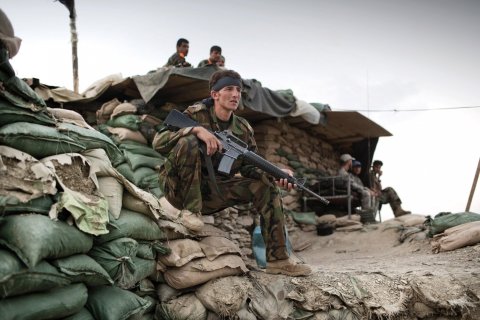
"There's nothing to do," the man said.
"Do they have any hobbies or talents, like sewing?"
He waved the question away. When he was gone, I told Cardinalli what he had said about the Americans destroying his country.
"They live in the security that we provide. They moved here because of us," Cardinalli said testily. "So we're destroying their country!"
We climbed back into the Max Pro. "It just sucks the life out of you, doesn't it?" Cardinalli asked me. "You end up kind of—sad."
She was not wrong about the complicated, parasitic relationship between the Afghans of Settlement 1 and the foreign troops who had taken up residence in Helmand. A trickle of mostly transitory Afghans—nomads, internally displaced people, returning refugees—had settled on the unwelcoming dirt around the American and British bases. Some undoubtedly hoped to benefit from their newfound proximity to foreigners, but the nature of that benefit was mixed. On the way back to Leatherneck, we stopped at a compound next to a stand of green vegetation. The plants were rooted in blackish mud, and a cornfield stretched along one side of the property. It was the only cultivated area in a sea of desert.
"This is the compound that flourishes from shit runoff," someone announced. I looked around and saw a dark stream. The Afghans were growing vegetables in the sewage runoff from the nearby military bases.
"We've told him about the health risks," one of the Marines said. "He moved here because of it. Says it's good fertilizer."
On the way back to the base, I asked a sergeant whether he thought giving out Crocs, notebooks, beans, and tea could sway local opinion about the Americans.
"Some of them like us, some of them don't," he told me. "I really don't know if we've had much effect changing people's minds."
He was right. When Lacy and I stopped by Fox Company's tent the following afternoon, we learned that a military convoy had hit a buried bomb just south of the second compound Cardinalli had visited; the Marines had found two other explosives buried in the road nearby. It was likely that the old man in the compound had seen the insurgents burying the bomb near his house, or at least heard about it. He had taken everything Cardinalli had to give, but he had said nothing to warn the Americans.
A fresh Human Terrain Team showed up at Leatherneck a few days later. AF7 was bound for Camp Dwyer, another base in Helmand. One morning, I found the new arrivals seated in a semicircle around AF6 team member Dunlap, who was briefing them about the area. The team's two social scientists, a fresh-faced young woman and a slight man in a black mock turtleneck, leaned in. A female Army major sat next to a young man in a T-shirt. The team leader, a silver-haired retired Marine officer, stood listening. Dunlap was telling them about the pro-NATO night letters she'd written for the British psychological operations guys.
"What are night letters?" one of the new team members asked.
Patiently, Dunlap explained.
The social scientist in the turtleneck spoke up. "Why don't they just put it in the mailbox," he asked, "rather than hang it up somewhere and see if they see it?"
Dunlap paused, unsure how to respond. "It's traditional," she finally said. "It's like a proclamation. This is the way they pass messages to the community."
AF7 had arrived at the beginning of a long-awaited troop surge in one of the most important parts of the country for the U.S. military, and they didn't know that mailboxes were all but obsolete in Afghanistan. Cardinalli had handed out Icy Hot to a woman with a medical condition that stemmed from having given birth to 10 children in a country with dismal health care and a soaring maternal mortality rate. Was this really the best we could do?
A FEW months before my visit to Helmand, Marine Corps Maj. Ben Connable had written that the Human Terrain System was a flimsy and transitory undertaking that devoured scarce resources yet was ill-equipped to meet the military's crying long-term need for better cultural intelligence. An Arabic speaker, Connable had served in Iraq and seen firsthand the consequences of Americans' paltry understanding of the people they were trying to win over. But he believed servicemen and servicewomen were smart and capable enough to learn this stuff on their own. They didn't need to outsource it to civilians. The military ought to take the problem seriously enough to invest in a durable, long-term solution, he argued. The Human Terrain System was just an expensive distraction.

Connable had a point, but the main problem with the Human Terrain System was much more basic: about half the Human Terrain Team members I met over 18 months in Afghanistan should never have been there. AF6 managed some modest accomplishments, but none of the Human Terrain Team members at Camp Leatherneck had the kind of expertise that field commanders told me they were looking for. Because the Marines in charge at Leatherneck didn't know what the Human Terrain Team was meant to accomplish, the team members did whatever they could, and whatever came up. Dunlap wrote night letters for the British psy-ops team because that was where she felt most able to contribute and where her contributions were most appreciated. Cardinalli's report on homosexuality among Pashtun men was used by a Marine intelligence sergeant to shame a young man he was questioning.
Lacy found that the only way he could gain traction within the Marine command culture in Helmand was by meeting the operational needs of the 2nd Marine Expeditionary Brigade, which in the fall of 2009 was primarily concerned with the impending invasion of Marja, a small farming community that had become a getaway zone for insurgents fleeing other parts of the province. That fall, a Marine officer asked Lacy to begin collecting cultural information and "open source intelligence" in preparation for the invasion of Marja. In a September 30 field report, Lacy detailed his interview with an Afghan police sergeant and landowner from the northern area of Marja, who identified the location of his home there and of a onetime police checkpoint, both of which had been taken over by insurgents. The Afghan marked the areas inhabited by several Pashtun subtribes, but he also supplied the name of the Taliban commander who had moved into his house and allegedly turned it into a bomb factory. The report included grid coordinates for important places in Marja, including the home of a local leader who had been killed by the Taliban; the home of an elder that had been occupied by the Taliban; a gas station used by insurgents "for refueling and as a gathering place"; and a Taliban checkpoint on the road to Lashkar Gah, "where the Taliban are reported to collect taxes from local residents." The source supplied the radio call sign for a Taliban commander who controlled most of eastern Marja and pointed out a minefield and a bridge rigged with explosives that the insurgents planned to use against ISAF forces. He also described the location of an insurgent campsite, a cemetery, a cellphone tower, several mosques, a school, and a number of key traffic intersections.
This was not the sort of cultural information the Human Terrain System had told commanders and the public it would be gathering; it sounded more like the Phoenix Program in Vietnam than a gentle effort to learn about local people. But this was exactly the kind of information the Marines wanted. "They have a hard time, any of these guys, distinguishing sociocultural information from intel," Lacy told me. "To them, it's all the same stuff, and in a way, it is. Quite frankly, intelligence, by doctrine, is not supposed to be just classified stuff."
By late 2009, the American Anthropological Association had conducted its own study of the Human Terrain System and concluded, correctly, that the teams were not doing anthropology. The distinction was important, but it didn't assuage the anger many anthropologists felt toward Montgomery McFate and her enterprise. Too many people still thought of the Human Terrain System as "that military-anthropology program," and too many press accounts still described it that way. The program had encouraged this confusion, even fed on it. In doing so, one anthropologist told me, the Human Terrain System had "set the relationship between anthropology and the government back 40 years."

WAR IS a form of hysteria to which no industry is more susceptible than defense contracting. Suddenly there is money for everything, but political will is fickle and Congress is mercurial. Manufacturers and program developers must move quickly before the funding dries up. The moment calls for speed, and speed calls for cutting corners.
The Human Terrain System had grown too fast. "We thought we had five teams and two years to build them, and it turned out we had to build 26 teams immediately," McFate told me. "It was kind of catastrophic." Recruitment was shoddy, and there were no systems in place to handle training and deploying so many teams. But the massive, heavy gears of the Pentagon had already begun to turn. Soldiers were dying, and the Army wanted what it wanted, and wanted it now.
I met colonels and generals who talked about the Human Terrain System as if it were the best thing that had ever happened to the Army. Mike Flynn, a sharp, contrarian general who served as the chief of NATO intelligence, published a paper in January 2010 calling for "sweeping changes to the way the intelligence community thinks about itself—from a focus on the enemy to a focus on the people of Afghanistan." Because the U.S. military had directed most of its intelligence efforts at insurgents, the intelligence community "still finds itself unable to answer fundamental questions about the environment in which we operate and the people we are trying to protect and persuade," Flynn and his coauthors wrote.
Human Terrain Teams could help solve this problem, Flynn believed. He called them an "extraordinary capability." "Whoever had that idea was a genius," he told me. What made the teams so valuable was precisely the fact that many of their members weren't "intel people," by which Flynn meant collectors or analysts who had spent their whole lives narrowly focusing on the enemy. "They're different and they're willing to take the risk," Flynn told me. "And these are people that absolutely have much better things to do, but they decided that they want to serve."
Did the people staffing Human Terrain Teams have much better things to do? Some did and some didn't. Some were bright, driven, talented people who contributed useful insights—but an equal number of unqualified people threatened to turn the whole effort into a joke. The Human Terrain System—which had been described in the pages of military journals and briefed to commanders in glowing, best-case-scenario terms—was ultimately a complex mix of brains and ambition, idealism and greed, idiocy, optimism, and bad judgment. "The problem with the Human Terrain System," Fondacaro told me, "is that we have too many humans."
But the problem with the Human Terrain System was bigger than that: it had everything to do with the contradiction between the United States' self-image as a benevolent superpower and the realities of war and the economy that drives it. By 2012, the Human Terrain System had cost U.S. taxpayers more than $600 million. Today, the program continues under new management (though only 14 field teams remain in Afghanistan, and none in Iraq). Last month, the Human Terrain System's current recruitment and hiring contractor, CGI Federal, was handed an additional $45 million for work related to the program.
The Army fired Fondacaro from his job as program manager in 2010, but in more optimistic times, he had spoken of the Human Terrain System as a kind of mini–State Department within the Defense Department. In fact, the program was a giant cultural metaphor, a cosmic expression of the national zeitgeist: American exceptionalism tempered by the political correctness of a postcolonial, globalized age and driven by the ravenous hunger of defense contractors for profit. If you could have found a way to project on a big screen the nation's mixed feelings about its role as the sole superpower in a post–Cold War world, this was what it would have looked like.
Adapted from The Tender Soldier by Vanessa M. Gezari. Published by Simon & Schuster, Inc. Copyright © 2013 by Vanessa M. Gezari.





